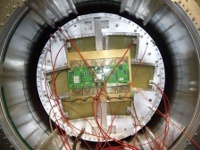 |
 |
|||||||||||||
|
|||||||||||||
|
|||||||||||||
|
The ILC detector activity entered a new stage with the submission of the three Letters of Intent and the start of evaluation by the International Detector Advisory Group (IDAG) (see my last article). This issue of ILC NewsLine is dedicated to these Letters of Intent or LOIs – one feature looks at how they will be evaluated by the advisory group, one at how they were written, and Barry’s Corner highlights some special R&D challenges where machine and detectors meet. During the TILC09 workshop in Tsukuba, the three concept groups made presentations on their detectors and physics performance which were attended by the IDAG members. The LOI process was initiated in October 2007 by the International Linear Collider Steering Committee (ILCSC) in order to advance designs of detectors for ILC. Each event, every time being a step forward, was introduced in some detail in the Research Director's Report of ILC Newsline when it was made. The identification of the concept groups, which submitted Expressions Of Interest in March last year, pledging to submit LOIs by the due date, and the formation of the five common task groups were the first step, made in spring last year, to organise the effort of the experiment and physics community which led after one year to successful completion of the three LOIs. The detector R&D and physics studies continue to advance. The RD management mechanism for detector activity was created to support and guide this work. Now that this structure is fully active, we anticipate a new phase of progress following validation. The validated groups will aim their efforts to completing the essential design and R&D by the end of the Technical Design Phase-II, which ends in 2012. The aim is to advance the R&D programmes to a level at which feasibility of the critical components is verified and necessary decisions of options can be made. We wish to establish well-defined baseline designs of optimised detector systems which can be integrated with the accelerator and can demonstrate desired physics performance. In parallel, physics studies should also develop with possible first results from CERN's Large Hadron Collider LHC. In 2010, I will make an interim report for which contributions from the concept groups and common task groups will be requested, reporting on their progress on the R&D and physics studies. While contacting with IDAG for validation, each concept group may need to prepare for this new step considering the obtainable resources. The LOI process should strengthen the effort of the detector groups to explain and justify their need for financial support to the respective funding agencies, and to secure that support. At the same time, we need to decide where to put our effort. The LOI can be a step for that. In this sense, we stand at a turning corner towards more selective R&D activities. -- Sakue Yamada, Research Director | |||||||||||||
| © International Linear Collider |
